谓语动词与前面的主语一致
- 格式:docx
- 大小:17.93 KB
- 文档页数:1

主谓一致和就近就远原则【1 】就近一致原则也称“临近原则”“就近一致原则”,即:谓语与接近的名词.代词(有时不一定是主语)在“人称.人数”上一致.一.在正式体裁中:1.由下列词语衔接的并列主语:“there be+句型;or either...or;nor;neither...nor;whether...or;not...but;not only...but also”等.Eg.(1)What he does or what he says does not concern me.他的行动或言谈与我无关.(2)Neither you nor I am wrong.你和我都没错.(3)Not you but your father is to blame.不是你,而是你的父亲该受责怪.(4)Not only you but (also) he is wrong.不但你错了,他也错了.2.在倒装句中,谓语可与后面第一个主语一致.Eg.(1)In the distance was heard the clapping of hands and the shouts of the people.在远处,能听见拍手和人们的呼叫招呼声.(2)There is (are) a pen and some books on the desk.桌上有一支钢笔和几本书.非正式体裁中:有时依“就近”和“意义”一致的原则;但语法上,“no one”才是主语,谓语要改成“agrees”.“写作中”一般要依“语法一致”原则.总结:英语就近原则短语1.There be句型 There is a book and some pencils on thedesk.=There are some pencils and a book on the desk.2.Neither...nor...Neither you nor he is right.=Neither he nor you are right.3.either...or...Either they or Jim is going to Shanghai next Saturday.=Either Jim or they are going to Shanghai next Saturday.4.not only...but also...Not only Ann but also her parents stay at home everySunday.=Not only Ann’s parents but also she stays at home every Sunday.就远原则谓语动词与前面主语一致代表词汇:as well as;(together/along)with;Ratherthan;except;besides;but;including;in addition to;apart from例子:He rather than I is right.Nobody but two students is in the classroom.主谓一致一、当主语后面与with,as well as,but,except,like,ratherthan,no less than,besides,including等+名词或代词连用时,谓语动词与第一个主语保持一致.1.The teacher,with 6 girls and 8 boys of herclass,___visiting a museum when the earthquake struck.A.wasB.wereC.had beenD.would be2.A library with five thousand books___to the nation as a gift.A.is offeredB.has offeredC.are offeredD.have offered3.E-mail,as well as telephone,___an important part in daily communication.4.Nobody but Jane___the secret.A.knowB.knowsC.have knownD.is known5.All but one___here just now.二.当either...or..;neither...nor..;not only...but also..等衔接并列主语时,谓语动词与接近它的主语保持一致.6.Either you or the headmaster___the prizes to these gifted students at the meeting.A.was handing outB.are to hand outC.are handing outD.is to hand out7.Not only I but also Jane and Mary____tired of having one examination after another.三.当“the only one of+复数名词+定语从句”,且关系代词在定语从句中作主语时,定语从句的谓语动词用单数情势,当“one of+复数名词+定语从句”,且关系代词在定语从句中作主语时,定语从句的谓语动词用复数情势.8.He is the only one of the students who___a winner of scholarship for three years.A.isB.areC.have beenD.has been9.She is one of the few girls who___in the kindergarten.A.is well paidB.are well paidC.is paying wellD.are paying well四.当news,means,maths,plastics,physics等在情势上是复数概念,而在意义上是单数概念的名词作主语时,谓语动词用单数情势. 10.Every possible means___to prevent the pollution,but the sky is still not clear.A.is usedB.are usedC.has been usedD.have been used五.当分数(百分数)+of+名词作主语时,谓语动词的数取决于of后面名词的数.11._____of the land in that distrcit_____covered with trees and glass.A.Two fifth;isB.Two fifth;areC.Two fifths;isD.Two fifths;are六.the number of...(...的数量)短语作主语时,谓语动词用单数情势;当 a number of...(很多...)短语作主语时,谓语动词用复数情势.12.The number of people invited___fifty,but a number of them___absent for different reasons.A.were;wasB.was;wasC.was;wasD.were;were七.当“疑问词+不定式”构造作主语时,谓语动词经常应用单数情势.13.When and where to build the new factory___yet.A.is not decidedB.are not decidedC.has not decidedD.have not decided。
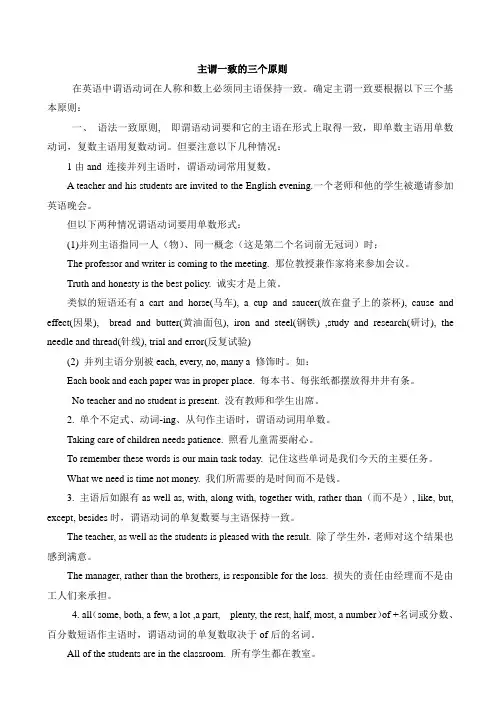
主谓一致的三个原则在英语中谓语动词在人称和数上必须同主语保持一致。
确定主谓一致要根据以下三个基本原则:一、语法一致原则, 即谓语动词要和它的主语在形式上取得一致,即单数主语用单数动词,复数主语用复数动词。
但要注意以下几种情况:1由and 连接并列主语时,谓语动词常用复数。
A teacher and his students are invited to the English evening.一个老师和他的学生被邀请参加英语晚会。
但以下两种情况谓语动词要用单数形式:(1)并列主语指同一人(物)、同一概念(这是第二个名词前无冠词)时;The professor and writer is coming to the meeting. 那位教授兼作家将来参加会议。
Truth and honesty is the best policy. 诚实才是上策。
类似的短语还有a cart and horse(马车), a cup and saucer(放在盘子上的茶杯), cause and effect(因果), bread and butter(黄油面包), iron and steel(钢铁) ,study and research(研讨), the needle and thread(针线), trial and error(反复试验)(2) 并列主语分别被each, every, no, many a 修饰时。
如:Each book and each paper was in proper place. 每本书、每张纸都摆放得井井有条。
No teacher and no student is present. 没有教师和学生出席。
2. 单个不定式、动词-ing、从句作主语时,谓语动词用单数。
Taking care of children needs patience. 照看儿童需要耐心。
To remember these words is our main task today. 记住这些单词是我们今天的主要任务。
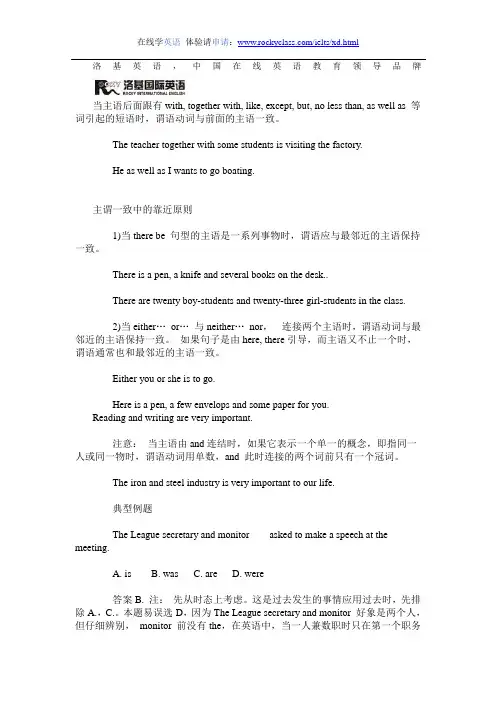
洛基英语,中国在线英语教育领导品牌当主语后面跟有with, together with, like, except, but, no less than, as well as 等词引起的短语时,谓语动词与前面的主语一致。
The teacher together with some students is visiting the factory.He as well as I wants to go boating.主谓一致中的靠近原则1)当there be 句型的主语是一系列事物时,谓语应与最邻近的主语保持一致。
There is a pen, a knife and several books on the desk..There are twenty boy-students and twenty-three girl-students in the class.2)当either…or…与neither…nor,连接两个主语时,谓语动词与最邻近的主语保持一致。
如果句子是由here, there引导,而主语又不止一个时,谓语通常也和最邻近的主语一致。
Either you or she is to go.Here is a pen, a few envelops and some paper for you.Reading and writing are very important.注意:当主语由and连结时,如果它表示一个单一的概念,即指同一人或同一物时,谓语动词用单数,and 此时连接的两个词前只有一个冠词。
The iron and steel industry is very important to our life.典型例题The League secretary and monitor ___ asked to make a speech at the meeting.A. isB. wasC. areD. were答案B. 注:先从时态上考虑。
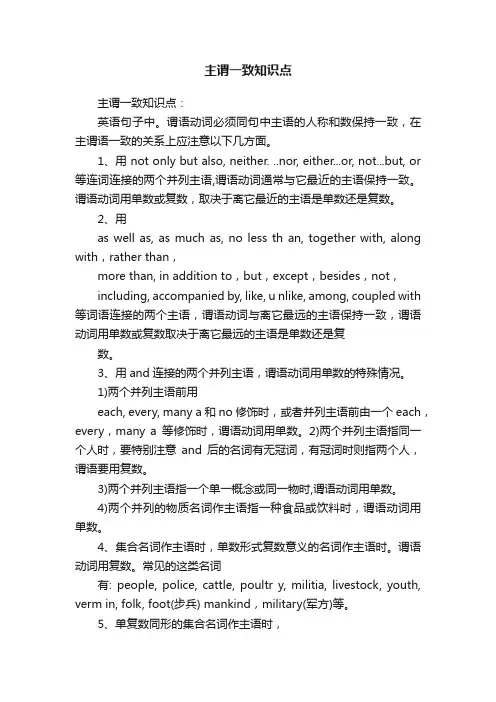
主谓一致知识点主谓一致知识点:英语句子中。
谓语动词必须同句中主语的人称和数保持一致,在主谓语一致的关系上应注意以下几方面。
1、用 not only but also, neither. ..nor, either...or, not...but, or 等连词连接的两个并列主语,谓语动词通常与它最近的主语保持一致。
谓语动词用单数或复数,取决于离它最近的主语是单数还是复数。
2、用as well as, as much as, no less th an, together with, along with,rather than,more than, in addition to,but,except,besides,not,including, accompanied by, like, u nlike, among, coupled with 等词语连接的两个主语,谓语动词与离它最远的主语保持一致,谓语动词用单数或复数取决于离它最远的主语是单数还是复数。
3、用and连接的两个并列主语,谓语动词用单数的特殊情况。
1)两个并列主语前用each, every, many a和no修饰时,或者并列主语前由一个each,every,many a等修饰时,谓语动词用单数。
2)两个并列主语指同一个人时,要特别注意and后的名词有无冠词,有冠词时则指两个人,谓语要用复数。
3)两个并列主语指一个单一概念或同一物时,谓语动词用单数。
4)两个并列的物质名词作主语指一种食品或饮料时,谓语动词用单数。
4、集合名词作主语时,单数形式复数意义的名词作主语时。
谓语动词用复数。
常见的这类名词有: people, police, cattle, poultr y, militia, livestock, youth, verm in, folk, foot(步兵) mankind,military(军方)等。
5、单复数同形的集合名词作主语时,谓语动词用单数或复数,取决于该名词是表团体还是表团体中各个成员。

主谓一致是指谓语动词在人称和数上必须与主语一致。
下面让我们看看不同类型的主谓一致。
1. 名词做主语(1)单复数主谓一致A) 一般词汇:有些词汇的复数形式是固定不变的,如:crossroads (十字路口;聚焦点), headquarters (总部), means (方法,手段), species (种类,品种), ser ie s (系列)等,但其动词的单复数取决于两点:a) 取决于限定词:例:Every means has been tr ie d but without much result.(各种方法都试过,可没有多大效果。
)b) 取决于上下文内容、作者所要表达的意思、特指还是泛指:例:Are/ Is there any other means of solving the problem?(还有什么其它解题的方法吗?注意:这里可以用are表示其它方法,也可以用is表示和现在所用的方法相对比的另一种方法。
)My favorite book is The Old Man and the Sea.(我喜爱的书是《老人与海》。
注意:本句是特指。
)Our TV ser ie s are much better than those of Japan.(我国的电视剧比日本的好得多。
注意:本句是泛指。
)c) 从句做主语How to develop a healthy habit is a good question to discuss.d) 学科名词一般用单数谓语动词。
这样的词有:economics(经济学), electronics(电子学), mathematics(数学), politics(政治学)等等。
例:Politics is a good topic for discussion.(政治是谈论的好题目。
)e)有些表示成双成对的词,常常只用复数形式,动词一律用复数,也不能用不定冠词。
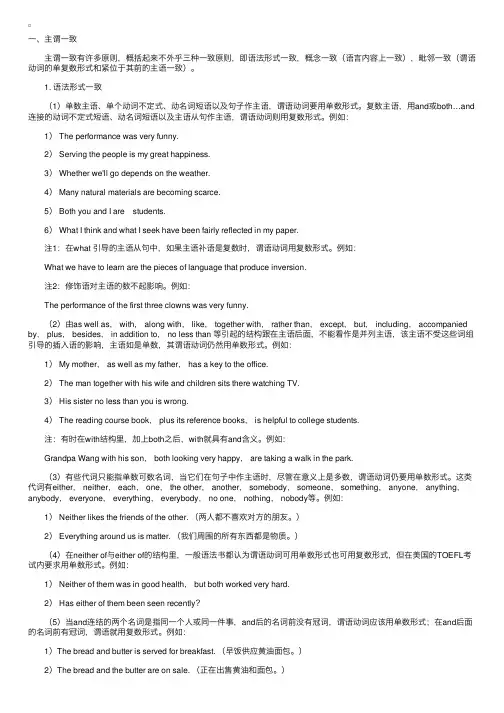
⼀、主谓⼀致 主谓⼀致有许多原则,概括起来不外乎三种⼀致原则,即语法形式⼀致,概念⼀致(语⾔内容上⼀致),毗邻⼀致(谓语动词的单复数形式和紧位于其前的主语⼀致)。
1. 语法形式⼀致 (1)单数主语、单个动词不定式、动名词短语以及句⼦作主语,谓语动词要⽤单数形式。
复数主语,⽤and或both…and 连接的动词不定式短语、动名词短语以及主语从句作主语,谓语动词则⽤复数形式。
例如: 1) The performance was very funny. 2) Serving the people is my great happiness. 3) Whether we'll go depends on the weather. 4) Many natural materials are becoming scarce. 5) Both you and I are students. 6) What I think and what I seek have been fairly reflected in my paper. 注1:在what 引导的主语从句中,如果主语补语是复数时,谓语动词⽤复数形式。
例如: What we have to learn are the pieces of language that produce inversion. 注2:修饰语对主语的数不起影响。
例如: The performance of the first three clowns was very funny. (2)由as well as, with, along with, like, together with, rather than, except, but, including, accompanied by, plus, besides, in addition to, no less than 等引起的结构跟在主语后⾯,不能看作是并列主语,该主语不受这些词组引导的插⼊语的影响,主语如是单数,其谓语动词仍然⽤单数形式。
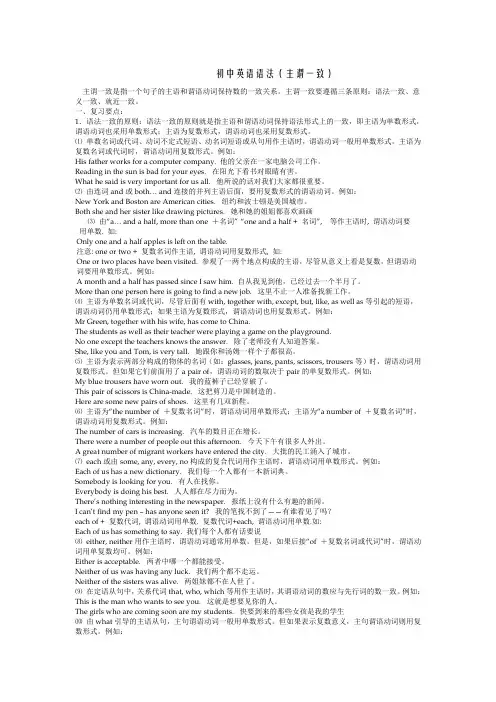
初中英语语法(主谓一致)主谓一致是指一个句子的主语和谓语动词保持数的一致关系。
主谓一致要遵循三条原则:语法一致、意义一致、就近一致。
一、复习要点:1.语法一致的原则:语法一致的原则就是指主语和谓语动词保持语法形式上的一致,即主语为单数形式,谓语动词也采用单数形式;主语为复数形式,谓语动词也采用复数形式。
⑴单数名词或代词、动词不定式短语、动名词短语或从句用作主语时,谓语动词一般用单数形式。
主语为复数名词或代词时,谓语动词用复数形式。
例如:His father works for a computer company. 他的父亲在一家电脑公司工作。
Reading in the sun is bad for your eyes. 在阳光下看书对眼睛有害。
What he said is very important for us all. 他所说的话对我们大家都很重要。
⑵由连词and或both… and连接的并列主语后面,要用复数形式的谓语动词。
例如:New York and Boston are American cities. 纽约和波士顿是美国城市。
Both she and her sister like drawing pictures. 她和她的姐姐都喜欢画画⑶由―a… and a half, more than one +名词‖―one and a half + 名词‖, 等作主语时, 谓语动词要用单数. 如:Only one and a half apples is left on the table.注意: one or two + 复数名词作主语, 谓语动词用复数形式, 如:One or two places have been visited. 参观了一两个地点构成的主语,尽管从意义上看是复数,但谓语动词要用单数形式。
例如:A month and a half has passed since I saw him. 自从我见到他,已经过去一个半月了。
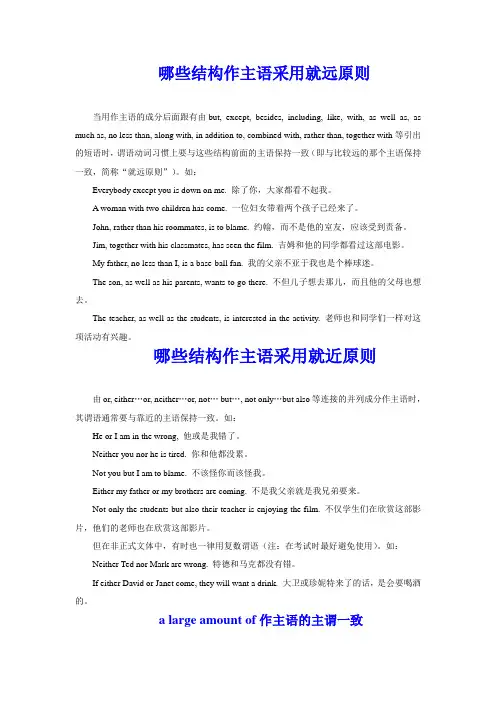
哪些结构作主语采用就远原则当用作主语的成分后面跟有由but, except, besides, including, like, with, as well as, as much as, no less than, along with, in addition to, combined with, rather than, together with等引出的短语时,谓语动词习惯上要与这些结构前面的主语保持一致(即与比较远的那个主语保持一致,简称“就远原则”)。
如:Everybody except you is down on me. 除了你,大家都看不起我。
A woman with two children has come. 一位妇女带着两个孩子已经来了。
John, rather than his roommates, is to blame. 约翰,而不是他的室友,应该受到责备。
Jim, together with his classmates, has seen the film. 吉姆和他的同学都看过这部电影。
My father, no less than I, is a base-ball fan. 我的父亲不亚于我也是个棒球迷。
The son, as well as his parents, wants to go there. 不但儿子想去那儿,而且他的父母也想去。
The teacher, as well as the students, is interested in the activity. 老师也和同学们一样对这项活动有兴趣。
哪些结构作主语采用就近原则由or, either…or, neither…or, not…but…, not only…but also等连接的并列成分作主语时,其谓语通常要与靠近的主语保持一致。
如:He or I am in the wrong, 他或是我错了。
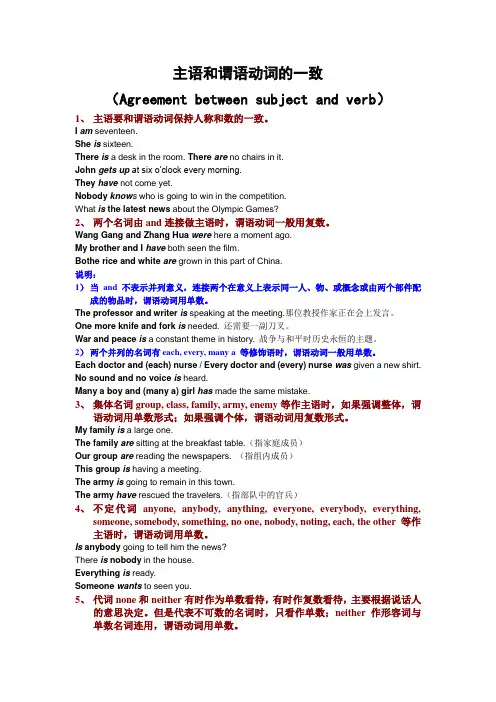
主语和谓语动词的一致(Agreement between subject and verb)1、主语要和谓语动词保持人称和数的一致。
I am seventeen.She is sixteen.There is a desk in the room. There are no chairs in it.John gets up at six o’clock every morning.They have not come yet.Nobody know s who is going to win in the competition.What is the latest news about the Olympic Games?2、两个名词由and连接做主语时,谓语动词一般用复数。
Wang Gang and Zhang Hua were here a moment ago.My brother and I have both seen the film.Bothe rice and white are grown in this part of China.说明:1)当and 不表示并列意义,连接两个在意义上表示同一人、物、或概念或由两个部件配成的物品时,谓语动词用单数。
The professor and writer is speaking at the meeting.那位教授作家正在会上发言。
One more knife and fork is needed. 还需要一副刀叉。
War and peace is a constant theme in history. 战争与和平时历史永恒的主题。
2)两个并列的名词有each, every, many a 等修饰语时,谓语动词一般用单数。
Each doctor and (each) nurse / Every doctor and (every) nurse was given a new shirt. No sound and no voice is heard.Many a boy and (many a) girl has made the same mistake.3、集体名词group, class, family, army, enemy等作主语时,如果强调整体,谓语动词用单数形式;如果强调个体,谓语动词用复数形式。
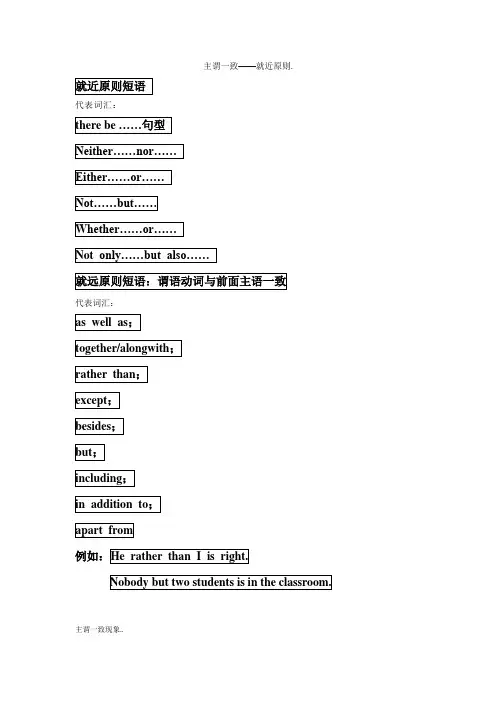
主谓一致——就近原则.代表词汇:代表词汇:主谓一致现象..有一类连接词;其后的谓语动词要与连接词前一部分的主语保持一致..此类连接词有with; along with; together with; as well as; besides; like; without; except but; including等..例如:Tracy; like many girls; loves dancing. 特蕾西像很多女孩一样;喜欢跳舞..All the students; including Tom; are leaving. 所有的学生;包括汤姆都走了..No one except but me knows about this news. 除了我没有人知道这个消息..就近原则现象..还有另一类连接词;句中的谓语动词要与靠近的主语保持一致..此类连接词有or; either... or; neither...nor; not only... but also等..例如:Neither you nor I am wrong. 你和我都没错..Not only the students but also the teacher wishes for a holiday. 不仅是学生;就连老师也期盼一个假期..1.There be 句型There is a book and some pencils on the desk.=There are some pencils and a book on the desk.2.neither...nor... Neither you nor he is right.= Neither he nor you are right.3.either...or... Either they or Jim is going to Shanghai next Saturday.= Either Jim or they are going to shanghai next Saturday.4.not only...but also... Not only Ann but also her parents stay at home every Sunday.= Not only Ann's parents but also she stays at home every Sunday.百度词条:就近原则也称“邻近原则”“就近一致原则”Proximity;即:谓语与靠近的名词、代词有时不一定是主语在“人称、数”上一致..I.在正式文体中:1.由下列词语连接的并列主语:"or ; either …or;nor; neither…or;whether…or;not…but; not only…but also" ; 等..e.g.①What he does or what he says does not concern me . 他的行为或言谈都与我无关..②Neither you nor I am wrong . 你和我都没错..③Not you but your father is to blame . 不是你;而是你父亲该受责备..④Not only you hutalso he is wrong .不仅你错了;他也错了..2. 在倒装句中:谓语可与后面第一个主语一致..e.g.①In the distance was heard the clapping of hands and the shouts of the people . 在远处;能听见鼓掌声和人们的呼喊声..②There is are a pen and some books on the desk .桌上有一支钢笔和几本书..II. 非正式文体中:有时依“就近一致原则”;但也可依“意义一致原则”或严格地依“语法一致原则”..e.g.Neither she nor I were there 意义一致我和他当时都不在那儿..非正式Neither she nor I was there .就近一致译文同上句正式但是;如果依“就近一致原则”而与其他两项原则相矛盾时;则常常认为是不太合符规范的..e.g.No one except his own supporters agrees with him .仅他自己的支持者同意他的意见..依“就近”和“意义”一致的原则;但语法上;“No one ”才是主语;谓语要改成“agrees”..“写作中”一般要依“语法一致”原则..主谓一致分为两大类:就近一致原则和意义一致原则..就近一致原则指的是;以靠近谓语动词的;作主语的名词作为人称和数的参考标准..意义一致原则指的是;必须分析主语属于单数或是复数;可数或是不可数;然后才能决定谓语动词的人称和数的形式..就近一致原则1连词not only...but also/ neither...nor/ or/ either...or/ not...but<><><>Not only the students but also the teacher is enjoying the film.不仅学生而且老师都在津津乐道地看着电影..Neither the students nor the teacher knows anything about it.同学们和老师对此都一无所知..Neither he nor they are wholly right.他和他们;谁都不是完全对的..Either he or I am right.或者他对;或者我对..就近一致原则2副词here/ there<><><>Here comes the bus.瞧;公共汽车来了..Here is a pencil-box for you.这儿有一个铅笔盒要给你..Here are my replies to your questions.这些是我针对你的问题的回答..There is an apple; two bananas and some oranges on the plates.盘子里有一个苹果;两条香蕉和一些桔子..主谓一致:andand的两边分别是不同的可数名词..John and Mary are my friends.约翰和玛丽都是我的朋友..<><><>and的两边分别是不同的不可数名词..Both rice and wheat are grown in China.中国有种水稻也有种小麦..<><><>and的两边的单词构成一个统一的概念..那位诗人兼作家来了..同一个人既是诗人又是作家主谓一致指的是句子的谓语动词与其主语在数上必须保持一致;句子的主语是第三人称单数;其谓语动词须用单数;主语是复数;则谓语动词用复数..1.主谓一致的三个原则..英语中的主谓一致主要遵循三个原则:意义一致原则、语法一致原则和就近原则..这三个原则常常发生矛盾;但当发生冲突时;意义一致原则为优先考虑的原则..1语法一致原则:主语和谓语通常是在语法形式上取得一致;即主语是单数形式;谓语动词也应采取单数形式;主语是复数形式;谓语动词也应采取复数形式..She is a girl.她是女孩..They are all girls.她们都是女孩..The professor and writer is invited to many universities to deliver lectures.这位教授兼作家被邀请到很多大学作报告..教授与作家是同一个人;是单数.The old are very well taken care of in our city.老年人在我们城市被照顾得很好.. the old 指所有的老年人;指一类人;为复数概念..2就近原则:谓语动词的人称和数由靠近它的主语决定..There is a book;two pens and three pencils on the desk.书桌上有一本书;两支钢笔和三支铅笔..There are two pens;a book and three pencils on the desk.书桌上有两支钢笔;一本书和三支铅笔..Either my sisters or my mother is coming.不是我的姐妹们就是我的妈妈要来..3意义一致原则:主语形式上是单数;但表达复数意义;那么谓语动词要用复数形式;或主语形式上是复数;但表达单数意义;则谓语动词也采用单数形式..The police are still running after the murderer.警察还在追杀人犯..The news was very exciting.这则新闻令人激动..My family were watching TV at 7 o'clock.7点钟的时候;我们全家人在看电视..My family has moved three times.我们家搬过三次..2.主谓一致的应用..1单一主语的情况..单一主语指的是由一个中心名词或名词短语构成的主语;其主语与谓语的一致情况如下:①不定代词作主语a.不定代词either; neither; each; one; the other;another;someone;somebody;something;anyone;anybody;anything;everyone; everybody;everything; nobody; no one; nothing等作主语时;谓语动词常用单数、b. none作主语时如果指人或可数的物;表数目;谓语动词单复数形式皆可;如果指不可数名词;表量;谓语动词用单数..Jimmy has used up all the money. None is left.吉米把所有的钱都用光了;一点没留..c. neither/either of+复数名词或复数形式的代词;谓语动词可用单数;也可用复数..Neither of these words is correct.这些单词没有一个是正确的..d. the other two…;the other three…another two ... ; both等作主语时谓语动词用复数、Five people came to help;but another three were still needed.已经有五个人来帮忙了;但我们还需要三个e. all指人时作主语;谓语动词用复数;指全部事情时;谓语动词常用单数‘All the work was finished.所有的活都干完了All is going well一切都很正常.f.在each… . and each;every….and every;no….and no;many a. . . and many a等由and连接并列单数主语的结构中;谓语动词用单数、Each boy and each girl has got a seat.每个男孩和女孩都有一个座位.Every man and everv woman is at work.每个男人和女人都在工作.No sound and no voice is heard for a long while.很长时间没有听到一点声音Every boy and every girl likes the film star.所有的男孩和女孩都喜欢这个电影明星g. such山作主语时;谓语动词的单复数形式应根据其意义而定、Such is Stephen Hawking;who has suffered a great deal but achieved so much.这就是史蒂芬·霍金;遭受着巨大痛苦而作出巨大成就的人..Such as have plenty of money want more money.那些有足够钱的人还想要更多的钱..②集合名词作主语a.有些集体名词;如people; cattle; police等形式上是单数;但意义上是复数;谓语动词需用复数..People are talking about the accident happened yesterday.人们还在谈论昨天发生的那场事故..b.集合名词;如audience观众;army; class; crew船员;company公司;crowd人群;enemy;family; group; government政府;public 公众;population人口;team队员等作主语时;若作为一个整体看待;谓语用单数;若着眼于组成该集体的一个个成员或个体时;谓语就该用复数..The population in China is very large and 80% of the population live in rural areas.中国人口很多;其中80%的人住在农村..c. 有些以-sh; -ese ; -ch结尾的表示国家、民族的形容词与the连用时表示复数含义;谓语动词用复数如the English; the Chinese;the French等The English are a polite people.英国是一个礼仪之邦..③以复数形式结尾的特殊名词作主语a.以一ics结尾的表示学科名称的名词作主语时;谓语用单数.Politics is taught in our school.我们学校开设政治课..b.专有名词如国名、人名、书名、组织机构等作主语;形式上即使是复数;谓语动词也要用单数;如the United Nations; the United States;the New York Times等..Lu Xun's works sells well. 鲁迅的着作很畅销..c.有些名词如..arnings; thanks; goods; leavings残渣;剩余;clothes; trousers; belongings 财产;savings; scissor;等作主语;其谓语动词只能用复数形式The family were saved but the belongings were lost.这一家人获救;但损失了所有财产..d. means ; sheep ; leer; crossroad、等单复数同形的名词作主语;谓语动词根据其单复数而定Each means has been tried to solve the problem;but none is effective.每一种方法都试过;但没有一个是有效的..④含有修饰语的名词作主语a一些由两个对应部分组成一体的复数名词;如trousers ; pants; glasses; scissgrs等作主语;前面若无a pair of; a suit of; a set of; a series of等这类单位词;通常作复数用;谓语动词作复数..若带有单位词;则由单位词的单复数决定谓语动词的单复数形式..My shoes are under the bed.我的鞋在床下..His black trousers are too long.他的那条黑裤子太长了..Your glasses are on your nose.你的眼镜在鼻子上..但若这类名词与a pair连用时;谓语动词往往用单数..This pair of shoes is made in Beijing.这双鞋子是北京制造的..There is a pair of glasses on your bed.你的床上有副眼镜..b. a number of'意为“许多”;修饰可数名词复数时谓语一般也用复数:the number of 意为“……的数目”;作主语时;谓语·只能用单数A number of the other plants were found in America.在美洲还发现了许多别的植物..The number of people who travel by plane in China is larger than ever before.在中国乘飞机旅行的人数比以往多了..c.只修饰可数名词的量词several; a few; few; quite a few; a great manvof...作主语;谓语动词应用复数形式;其修饰的名词作主语、谓语动词也应用复数形式Usually few regard their work as a pleasure. 通常很少有人把工作当成娱乐..d. some; plenty of'; a lot of ; lots of等词既可修饰可数名词;又可修饰不可数名词;谓语的形式应根据所修饰词而定、A lot of students are coming to the meeting.很多学生要来参加这次会议..A lot of work is to be done to prepare for the conference.为了准备会议;还有很多工作要做..〔注意」a quantity of ; large quantities of作主语或其修饰的名词作主语;谓语动词应根据quantity的单复数形式而定..Quantities of money are needed to equip the school.学校安装设备需要很多钱..A quantity of story books has been bought for the children.为孩子们买了大量的故事书:e. a great/ good deal of;a little;quite a little;a large amount of等修饰不可数名词的量词作主语或修饰的名词作主语;谓语动词只能用单数形式A great deal of time was wasted playing but ought to have been fully used.很多时间在玩耍中浪费掉了;但本应好好利用的f. "more than one十单数名词”尽管意义上是复数;但因中心词是单数形式;谓语也必须用单数以符合语法一致的原则在“more+复数名词+than one”结构之后;谓语常用复数.More than one person was injured in the accident.不止一人在这次事故中受伤-More members than one are against the proposal.反对这项提议的会员不止一个g. "one or two +复数名词”作主语时;谓语动词用复数One or two students were planting trees yesterday afternoon.昨天下午有一两个学生在植树h.表示时间、距离、价格、度量衡的复数名词与pass; go by;waste; use; spend等词连用时;谓语动词用复数Five years have passed since I joined the Party.我入党五年了i. one or two 后接复数名词;谓语要用复数但在“a/an十单数名词+or two”结构之后;谓语却常用单数One or two days are enough for this work.=A day or two is enough for this work.干这活一两天就够了j. the restof…;the remaining;partof...;one half' of…等词或短语作主语和它们所修饰的名词或代词作主语;谓语动词应根据主语所表达的单复数而定Part of his story was not true.他讲的故事有一部分不是真的..Part of the foreign teachers in our school are from Canada.我们学校一部分外籍教师来自加拿大.k.当“几分之几百分之几+ of+名词”结构作主语时;一般也应根据of后的名词的单复数决定谓语动词的单复数"one and a half +复数可数名词”作主语;谓语一般用单数.This is because two thirds of the earth's surface is made up of vast oceans.这是因为地球表面积的2/3是由广阔的海洋构成的Two thirds of these tasks have been completed.这些任务已经完成了三分之..One and a half days is all I can spare.我只能抽出一天半的时间It is reported that in this area one in four people suffers from lung cancer.据报道在此地区有四分之一的人患肺癌一般情况下;one in ten作主语和其修饰的名词作主语;谓语动词用单数形式2非谓语形式、从句作主语①单独的不定式、动词的一ing形式作主语时;谓语动词一般用单数形式:如果多个非谓语动词连在一起表达同一概念;谓语动词用单数形式;如果表达不同概念;谓语动词用复数Persuading him to join us seems really hard.劝他加入我们似乎很难..To go to bed early and to rise early is a good habit.早睡早起是好习惯..To work and to live are two different things but they are always together.虽然工作和生活是两件不同的事情;但是它们永远相伴..②that;what;who;which;when;where;why;whatever; whoever;whichever; whenever; whereve:等引导的从句作主语或单独引导疑问句时;应根据概念上一致的原则决定谓语动词的数"That .lack has gone abroad makes us all surprised.杰克出国去了使我们都很惊讶Who is Abraham Lincoln林肯是谁Who are talking with each other谁在相互讨论3以并列结构作主语的主谓一致①and及both... and...a. 一般来说;两个单数主语用and连接起来;表示两个不同的人或物;谓语动词用复数;但如果两个并列的单数主语在意义上指同一个人、同一个事物或同一个概念;谓语动词必须用单数A smile and handshake show welcome.微笑和握手表示欢迎The poet and writer has produced many works.这个诗人兼作家写出很多作品、b.并列主语由or; either.. . or. . . ; neither... nor. . . ; not only…but also…连接时;谓语动词常与邻近的主语保持人称、数的一致Either the teacher or the students are to blame. 或者是老师;或者是学生要受到责备Not only the students but also their teacher doesn't know about it.不仅仅是学生;还有他们的老师都对此一无所知_Neither you nor I am fit for the work.你和我都不适合干这个工作-Are neither you nor I fit for the work你和我都不适合干这个工作吗4假性主语的主谓一致with;together with连同;along with和·····一起;as wellas也;like诸如;such as诸如;as much as; no less than和····一样;rather than而不是;including; besides; but;except; in addition以除……之外等短语后的主语称为假性主语;谓语动词仍然根据原主语而定;不跟假性主语一致..The boy with his dog is here.这个男孩在这儿;还有他的狗No one but your parents was there then.那时;除了你的父母没有别人在那里Tom;together with Mary and Alice;is going to swim this afternoon.汤姆今天下午要和玛丽及艾丽丝去游泳The teacher;including his students;is going to see Professor Smith.那位老师和他的学生们将去看望史密斯教授、5由there ; here引导的主语不止一个时;谓语通常和最邻近的主语保持一致、There is a lake and some hills around it.它被一个湖和几座刁、山环绕着、6定语从句中的谓语动词应视先行词的单复数而定;先行词是单数;定语从句中的谓语动词也用单数;先行词是复数;定语从句中的谓语动词也用复数Thosepeoplewho are for this plan are to sign your nameright on this paper.同意这个计划的在这张纸上签名I will always treasure the moments that were full of pleasures.我将永远珍惜充满欢乐的时光:The news that has been published in today's newspaper isn't true.今天报纸上发布的新闻不是真的..7在倒装句中谓语应与后面的主语保持一致..On the wall hang some pictures by Picasso.墙上挂着一些毕加索的画..8运算数词作主语时;谓语动词用单数..Three times five is fifteen. 3乘5等于15Five minus four is one. 5减4等于1..Seven times four makes twenty-eight. 7乘4等于g9表示数量的“one and a half+复数名词”作主语时;谓语动词要用单数..One and a half bananas is left on the table.桌子上还剩有一个半香蕉..One and a half hours is enough一个半小时足够了..。

主谓一致是指谓语动词在人称和数上必须与主语一致。
下面让我们看看不同类型的主谓一致。
1. 名词做主语(1)单复数主谓一致A) 一般词汇:有些词汇的复数形式是固定不变的,如:crossroads (十字路口;聚焦点), headquarters (总部), means (方法,手段), species (种类,品种), ser ie s (系列)等,但其动词的单复数取决于两点:a) 取决于限定词:例:Every means has been tr ie d but without much result.(各种方法都试过,可没有多大效果。
)b) 取决于上下文内容、作者所要表达的意思、特指还是泛指:例:Are/ Is there any other means of solving the problem?(还有什么其它解题的方法吗?注意:这里可以用are表示其它方法,也可以用is表示和现在所用的方法相对比的另一种方法。
)My favorite book is The Old Man and the Sea.(我喜爱的书是《老人与海》。
注意:本句是特指。
)Our TV ser ie s are much better than those of Japan.(我国的电视剧比日本的好得多。
注意:本句是泛指。
)c) 从句做主语How to develop a healthy habit is a good question to discuss.d) 学科名词一般用单数谓语动词。
这样的词有:economics(经济学), electronics(电子学), mathematics(数学), politics(政治学)等等。
例:Politics is a good topic for discussion.(政治是谈论的好题目。
)e)有些表示成双成对的词,常常只用复数形式,动词一律用复数,也不能用不定冠词。
主语和谓语保持一致叫主谓一致,即谓语动词的形式必须随着主语单、复数形式的变化而变化;主谓一致原则:1、语法上的一致所谓语法一致原则,即主语和谓语的语法形式在人称和数上取得一致;谓语的单、复数形式依据主语的单、复数形式而定:主语为复数,谓语动词用复数;主语为单数或者是不可数名词,谓语动词用单数;China belongs to the Third World. 中国属于第三世界;We are sure he will come. 我们肯定他会来;使用语法一致的情况1当主语是and,both…and连接的并列结构如果主语指的是两个或两个以上的人或物,则谓语动词用复数;My mother and I have seen the film. 我妈妈和我已看过这部电影;Both rice and wheat are grown in this part of China. 在中国的这个地方既种稻子又种小麦;注意:由and连接的并列主语前面分别有each,every,no修饰时,其谓语动词用单数形式;Every boy and every girl has to receive education in our country. 在我国每一个男女孩子都得受教育;No student and no teacher was invited to the party. 师生没有被邀请参加晚会;2主语后面接说明主语的修饰语主语后面接说明主语的修饰语如:with,along with,together with,as well as,like,ratherthan,but,except,besides,including,in addition to,谓语动词不受修饰成分的影响,仍保持同主语一致的关系;The teacher with two students was at the meeting. 那位老师和两个学生参加了会议;The girl as well as the boys has learned to drive a car. 这个姑娘和男孩子一道,也学会了开汽车;A library with five thousand books is offered to the nation as a gift.一个有5000册书的图书馆作为礼物赠送给了国家;E-mail, as well as telephones, is playing an important part in daily communication.电邮和电话在日常的通信中起着很重要的作用;Nobody but Jane knows the secret.只有简知道这个秘密;All but one were here just now. 刚才除了一个人外都来了;3非谓语动词或从句作主语非谓语动词动词的-ing形式、不定式或从句作主语时,谓语一般用单数形式;When and where to build the new factory is not decided yet.什么时候在什么地方建新工厂还没定下来;Checking information is very important. 核实事实是非常重要的;To learn foreign languages is not easy. 学习外语并非易事;When we will hold the meeting is not decided yet. 我们何时开会尚未决定;注意:当what引导主语从句或由 and连接两个动词不定式或动名词作主语时,谓语动词的数应根据意义一致的原则来决定;What we need here is money.我们这里需要的是资金;What we need here are workers.我们这里需要的是工人;Lying and stealing are immoral.说谎与偷窃是不道德的;4each和复合不定代词作主语each和some/any/no一个比一个差;Nobody knows the answer. 没有一个人知道这答案;Someone wants to see you. 有人想见你;Is there anything in the box箱子里有什么东西吗There is a lot of milk in the bottle. 瓶子里有很多奶;5“many a +单数名词”作主语“many a、很多/more than one不只一个+单数名词”作主语时,谓语动词用单数形式;Many a student has been to Beijing. 很多学生去过北京;There is more than one answer to your question. 你的问题不只有一个答案;6“one of+复数名词十定语从句”之前有the等限定词和修饰语“one of+复数名词十定语从句”之前有the only,the very,the等限定词和修饰语时,定语从句的谓语动词用单数形式;Tom is the only one of those boys who is willing to help the old man.汤姆是唯一的一个愿意帮助那个老人的男孩;He is the only one of the students who has been a winner of scholarship for three years.他是这三年来唯一的一个获得奖学金的学生;注意:如没有这些限定词和修饰语,定语从句的谓语动词采用复数形式;Tom is one of the boys who are always ready to help others. 汤姆是个随时愿意帮助别人的男孩;7由两个部分组成的物体名词作主语英语中有些由两个部分组成的物体名称如g1asses眼镜,scissors剪刀,shorts 短裤,shoes鞋子,trousers裤子等作主语,其后的谓语动词用复数形式;His glasses were broken, so he can't see well. 他的眼镜碎了,因而看不清楚;His trousers are made of cotton. 他的裤子是棉布的;注意:若这类名词前带有pair等表示单位的名词时,则以这些名词的单、复数形式决定动词的形式;Two pairs of trousers are missing. 两条裤子不见了;This pair of shoes is not on sale. 这双鞋不出售;2、意义上的一致意义上的一致是指谓语动词与主语的一致取决于主语所表达的意义;若主语形式上为复数,而意义上是单数,动词要用单数;若主语形式上为单数,而意义上为复数,则动词用复数;The United States is in North America. 美国在北美洲;The police are looking into the matter. 警察正在调查此事;使意义上的一致的情况1由and连接两个并列主语其后的谓语动词一般用复数形式;但如果两个单数名词指同一个人、同一事物、单一概念时,谓语动词要用单数,有时两个名词共用一个冠词;The worker and writer has written a new novel. 这位工人兼作家写了一部新小说;两个名词共用一个冠词There is a journalist and writer living in America whose name is Alex Haley. 在美国有一个名叫亚利克斯哈利的记者兼作家;Truth and honesty is always the best policy. 真诚总是上策;注意:用and连接起来的两个单数主语,谓语动词可以是单数,也可以是复数;Three and five makes /make eight.三加五等于八;Time and tide wait/waits for no man .岁月不等人;2形复意单的名词作主语①复数形式的专有名词表示国家、城市、机构、组织以及书籍、报纸、杂志等做主语,通常作为整体看待,谓语动词用单数;The United States is in North America.美国在北美洲;The Arabian Nights is read all over the world.天方夜谭是流传世界各地的名着;The New York Times has a wide circulation.纽约时报销路很广;注意:表示山脉、群岛、瀑布等的专有名词和以复数形式出现的表示同姓的一家人或同名、同姓的若干人,谓语也用复数;The Alps rise over 4 countries.阿尔卑斯山脉跨越了四国;Niagara Falls are not as high as Victoria Falls.尼亚加拉瀑布没有维多利亚瀑布高;The Smiths were also invited.史密斯一家人也受到了邀请;There are 3 Marys and 2 Roberts in my class.我班有三个叫玛丽、两个叫罗伯特的学生;②以-ics结尾表示学科的名词做主语,通常表示单数意义,谓语动词用单数形式;这类名词有:physics, politics, mathematics, economics, athletics, electronics等;Politics is now taught in all schools.现在各学校都开设政治课;Economics is a science of the way in which industry and trade produce and use wealth.经济学是研究工业、贸易生财和用财之道;注意:当这些动词表示有关方面的活动、情况、见解、原理等意思时,谓语动词需用复数形式;What are his politics他的政见如何The economics of national growth are of the greatest importance to all modern governments.国家发展经济的原理对现代各国政府都重要;③news,maths,plastics,physics,works,means方法,the United States等虽然以-s结尾,但意义上作为单数看待;“News of victories keeps pouring in as our army advances,” the company commander said. 集团军司令说:”随着我们军队的推进胜利的消息接踵而至;”Mathematics/Physics is a required subject for us.数学/物理是我们必修的科目;Every possible means has been used to prevent the air pollution,but the sky is still not clear.所有可能的直至污染的方法都用了,但天空还是不晴朗的;④成对的名词做主语时用单数形式;Bread and butter is a daily food in the West .面包抹黄油是西方人每天的食品;His gratitude and devotion to the Party is endless.他无限感觉,无限忠于党;⑤“one and a half +复数名词”做主语,谓语动词用单数;One and a half pears is left on the table .一只半梨剩在桌子上;One and a half days is all I can spare.一天半是我所能挤出的全部时间;注意:“one or two+复数名词”做主语,谓语动词用复数;One or two days are enough to see the city.参观该市一两天就足够了;There are one or two things I want to talk over with you .我有一两件事想跟你商量;3有生命的集体名词作主语有生命的集体名词如people,police,cattle,militia作主语,谓语动词用复数形式;Cattle are also kept. 还养了一些牛;There are many people there. 那里有很多人;The police are looking for the thief. 公安人员在搜寻那个小偷;All the people of the world want peace.全世界人民都渴望和平;注意:family,team,class,government,audience,crew,committee等集体名词,如果作整体看待,谓语动词用单数形式;如果作个别成员看待,谓语动词用复数形式;people作“民族”解时,作单数用;Zhang’s family is rather big, with twelve people in all.张家很大,一共12口人;The family are sitting at the breakfast table. 这家人正坐在早餐桌旁;My family is a large one. 我家是个大家庭;The class are doing experiment in the lab. 全班同学正在实验室里做实验;The class has won the honour. 这个班获得了荣誉;The Chinese people is a great people.中华民族是一个伟大的民族;4 名词化的形容词作主语名词化的形容词作主语,按照意义一致的原则决定谓语动词的单、复数形式;如果指一类人,谓语动词用复数形式,如果指一个人或抽象概念,谓语动词用单数形式;这类形容词有:old, young, rich, poor, blind, deaf, dead, sick等;The rich are not always happy. 富人也有不开心的时候;The wounded is a policeman. 受伤者是一名警察;The beautiful is not always the same as the good. 漂亮的不一定就等于好;5 表示时间、距离、金钱、重量等的复数名词作主语表示时间、距离、金钱、重量、度量、容量、温度等的复数名词做主语,通常看作一个整体,谓语动词用单数形式;Twenty years has passed since we left school. 我们离开学校已经20年了;Ten thousand dollars is a lot of money. 一万美元是一大笔钱;Two months is quite a long time. 两个月时间是很长的;Two hours is enough for us to do this experiment.我们做这个实验两个小时就够了;Thirty kilometres is a good 公里是一个相当远的距离;注意:如果说话人侧重一个个的个体,谓语动词用复数形式;Twenty years have passed since we parted.自从我们分手以后20年己经过去了;6“a number of十复数可数名词”与“the number of十复数可数名词”作主语“a number of十复数可数名词”表示“一些、许多”的意思,谓语动词用复数;“the number of十复数可数名词”表示“……的数目、数量”,谓语动词用单数;The number of people invited was fifty, but a number of them were absent for different reasons.邀请来的人数是50,但很多人因不同的原因没来;A number of books are missing from the library.图书馆丢了许多书;The number of workers in this factory is increasing.这家工厂的工人数目正在增加;7none of和neither of后跟复数名词或复数代词作主语none of和neither of后跟复数名词或复数代词时,有时作单数看待,有时作复数看待,主要根据说话人的意思决定;None of them has arrived yet at the settlement. 他们没有一个到达新住宅区;None of them have arrived yet. 他们都还没到;8“分数/百分数+of短语”作主语“分数/百分数+of短语”作主语,这时要以of短语中的名词是否为复数而定;Two fifths of the land in that district is covered with trees and grass.该地区五分之二的土地为树木和草所覆盖;89% of smokers are male. 89%的吸烟者是男性;In the USA, 75% of the grain is used to feed animals. 在美国,75%的谷物用来喂养动物;Two-thirds of the earth's surface is sea. 地球表面的2/3是海洋;Two-thirds of the people were against the plan. 2/3的人都反对核计划;9表示部分概念或不定数量的名词或代词作主语表示部分概念或不定数量的名词或代词作主语,谓语动词用单数还是复数,应根据后接名词的单、复数形式而定;这些名间或代词有all,any,enough,half,more,most,the rest,part,some等;The rest of the buildings are easy to get to. 其余的建筑物并不难上;The rest of his life was happy. 他的晚年生活很幸福;Most of my time was spent in reading. 我大部分时间用来读书;Most of the people are aware of it. 大部分人都知道它;Some of the sugar was spilled on the floor. 一些糖散落在地上;Some of the apples were spilled on the floor. 一些苹果散落在地上;10两个主语,一个肯定,一个否定,谓语动词与肯定主语相一致;The parents, and not the son, were missing.失踪者不是儿子,而是他的双亲;3、邻近原则邻近原则是指谓语动词要与它最邻近的名词或代词保持人称与数的一致;Neither he nor I am a student. 他和我都不是学生;There is a pen , two chairs and a desk. 有一支钢笔,两把椅子和一张桌子;这主要有以下几种情况;1由or,either…or等连接的并列结构作主语由or、either…or、nor、neither…nor、not only…but also、not…but连接的并列主语,通常按照就近一致原则,谓语动词的单、复数形式依照靠近它的主语而定;Either you or the headmaster is to hand out the prizes to these gifted students at the meeting.要么你要么校长在会议上对这些天才的学生颁奖;Neither he nor I have finished the experiment. 他和我都没有做完试验;Either his friends or his brother is wrong. 不是他的朋友们错了,就是他哥哥错了;Not only I but also Jane and Mary are tired of having one examination after another.不仅我而且简和玛丽都讨厌一个接一个的考试;Not only the teacher but also his students have studied the question. 不仅老师而且他的学生们都研究了这个问题;2在主谓倒装句时在主谓倒装句中,主语并列,谓语动词的人称和数与最近的主语相一致;由here或there引导的句子,若有并列主语,谓语也与最靠近的那个主语一致;There is a desk, a table and three chairs in the room. 房间里有一张书桌、一张饭桌和3把椅子;There are three chairs, a desk and a computer in the room. 房间里有3把椅子、一张书桌和一台电脑;Where is your wife and children to stay while you are away你不在时妻子和孩子呆在哪儿"表里不一"现象:以-s结尾的名词作主语的主谓一致:英语可数名词的规则复数形式是在词尾加-s或-es,但是有一些以-s结尾的名词并不是可数名词;它们用法多样,造成了实际使用上的困难,以下详述了以-s结尾的名词作主语的主谓一致问题;一以-s结尾的疾病名称作主语的主谓一致问题二以-s结尾的游戏名称作主语的主谓一致问题三以-s结尾的地理名称作主语的主谓一致问题四以-ics结尾的学科名称作主语的主谓一致问题五其它以-s结尾的名词的主谓一致问题集合名词的主谓一致原则:集合名词作主语时,主谓一致关系是一个较为复杂的问题.对此类问题我们可以从"数"的角度分为四类.1单数—复数型.凡是有复数词尾变化形式的集合名词都属于此类;如:a class—classes; a family—families; a government—governments; an army —armies; a people—peoples; a group—groups; a crowd—crowds; a crew —crews等;这类集合名词强调的是整体性,即当作一个整体或多个整体来看待;属于这类集合名词的单数作主语时,谓语动词用单数;复数形式作主语时,谓语动词用复数;例如A big crowd often gathers on the square every morning.每个上午一大群人经常聚集在广场上The government has decided to pass the bill.政府已决定通过这一法案There are huge crowds in the streets on Sunday.星期天有大群大群的人在街上;There are many English-speaking peoples in the world.在世界上有许多讲英语的人但应注意,这类集合名词的单数形式有时表示复数概念,所以这些集合名词的单数形式也可归为"单复同形型"中.2单数型.这类集合名词表示的是人或事物的整体,即把这类人或事物的全部包括在内,所以只有单数形式.如作主语,谓语动词常用单数;这类名词常见的有:humanity,mankind,proletariat等.例如The proletariat is the greatest class in the history of mankind. In the fields of production and scientific experiment,mankind makes constant progress.3复数型.这类集合名词在形式和内容上是相互矛盾的,就是说它们只有单数形式,但表达的都是复数概念;它强调的是集体中的个体性.这类名词有:police,cattle,faculty,flock,machinery,vermin,personnel等.它们作主语时,谓语动词要用复数.例如The police have caught the murder.Our personnel are very highly trained.The vermin are very dangerous.4单复同形型.这类集合名词的单数形式既可表示单数也可表示复数.作主语时,用单数动词或复数动词均可,有时意义区别不大.例如The school teaching staff are is excellent.The public is are requested not to litter in the park.The teaching profession claims to be badly paid.这类集合名词常见的有:class,family,team,crew,board,herd,committee,party,jury,enemy,audience 等.根据说话人的心理意向若把这个集合名词所代表的人或事物看作一个整体,就认为是单数,用单数动词;若把它所代表的人或事物看作若干个个体的话,就认为其为复数,用复数动词;试比较:The football team is playing well.那个足球队打得非常漂亮.The football team are shavings bath and are then coming back here for tea. 足球队员们正在洗澡,然后来这里吃茶点;The family is a very happy one.那个家庭是一个非常幸福的家庭;That family are very pleased about the news of William's success. 全家人对威廉的成功都感到很高兴;巧记主谓一致原则:单单复复最常见,集体名词谓用单,如若强调其成员,复数谓语记心间;有些名词谓常复,people,police即这般;主语单数后接介,谓语单数介无关,many a作主语也如此,谓语动词应用单;or、nor、but also、there be,近主原则挂嘴边;关系代词定主语,谓语根据先行词判;不定式短语、动名词,主语从句谓全单;时间、货币与距离,谓语多单复少见,rest,means,fol1owing等,意义决定其复、单;none,all,half of等,of之宾语定答案;还有分数、百分数,仍据of之宾定复、单;代词all指人谓复数,all指事情谓用单;量词用法请注意,谓语要随量词变;and连接两名词,身兼两职一定冠,no,each,every后单名,两件种事物系一概念,以上情况请记清,谓语动词全用单;形容词带the一类人,姓氏复数加定冠,-s结尾的海峡、山脉与群岛,谓语用复勿用单;neither,either,each,用作主语谓全单;。
主谓一致主谓一致Subject-Verb Concord即谓语动词在人称和数上要和主语保持一致;主谓一致包括语法一致、意义一致和就近一致;语法一致即谓语动词在单复数形式上要和主语保持一致;意义一致就是谓语动词要和主语意义上的单复数保持一致;就近一致就是谓语动词要和靠近它的主语部分保持一致..表里不一主谓一致中的"表里不一"现象1;"more than one +名词"作主语时;谓语动词常用单数.例如:More than one teacher gets the flowers. 不止一个教师得到了花. 2;"many a +名词"作主语时;从意义上看是复数;但谓语动词常用单数.例如:Many a student has been sent to plant trees. 很多学生被派去植树.3;"half of ;the rest of ;most of ;all of及百分数或分数+of 等后接名词"作主语时;谓语动词形式根据of后的名词而定.例如:Three fourths of the surface of the earth is covered with water.地球表面四分之三为水所覆盖.4;all指人时;动词用复数;all指物时;动词用单数.例如:"All are present and all is going well." 所有人全部到场了;一切进展顺利5;what引导的主语从句;谓语动词可视表语而定:表语是单数名词时;动词用单数;相反;则用复数.例如:What they want to get are a number of good books.他们想得到的是大量的好书.6;and连接的两个单数名词前若用each ;every ;no修饰;该名词短语作主语时;谓语动词用单数形式.例如:No book and no pen is found in the schoolbag.书包里没有书和钢笔.7;当主语后面有as well as ;with ;along with ;together with ;but ;like ;rather than ;except;逗号加and连接几个名词等引导的短语时;谓语动词要与最前面的主语保持一致.例如:My father as well as his workmates has been to Beijing. 我父亲和他的同事曾去过北京.8;each作主语的同位语时;谓语动词由主语来决定;与each无关.例如:They each have a bike. 他们每人有一辆自行车.9;动词不定式;动词-ing形式短语作主语时;谓语动词常用单数.例如:Going out for a walk after supper is a good habit.晚饭后出去散步是一个好习惯.10;the following作主语时;谓语动词的数与后面名词的数保持一致.例如:The following are good examples下面是一些好例子.11;以-ics结尾的学科名词;如politics ;physics ;mathematics等作主语时;谓语动词用单数.以-s结尾的名词news ;works ;plastics等同属此类.例如:Politics is now taught in all schools. 现在各学校都开设政治课.当以-ics结尾的学科名词表示"学科"以外的意义时;用作复数;如:mathematics运算能力politics政治观点economics经济意义等..12;有些用来表示由两个对应部分组成一体的名词复数trousers ;glasses ;shoes .shorts .scissors .scales等作主语时;前面若有"一条";"一副";"一把"之类的单位词;动词用单数;若没有单位词或单位词是复数;则谓语动词用复数.例如:The shoes are all right. 这些鞋子都很合适.还有一些以-s结尾的名词通常用复数:arms武器.clothes .contents .minutes记录.remains遗体.thanks等13;"one and a half +名词"作主语时;谓语动词要用单数.例如:One and a half apples is left on the table. 桌子上有一个半苹果.14;"One or two more +复数名词"作主语时;谓语动词用复数.例如:One or two persons are sent there to help them do the work. 要派一两个人到那儿去给他们帮忙.15;"one of+复数名词+ 定语从句"结构中;定语从句的谓语动词要用复数;而在"the only one of +复数名词+定语从句"的结构中;"the one of + 复数名词+定语从句"定语从句的谓语动词要用单数.例如:He is one of the students who get there on time.他是准时到达那里的学生之一.16;表示时间;距离;金钱等的复数名词作主语表达一个整体概念时;谓语动词常用单数;但若强调数量;谓语动词可用复数.例如:One million dollars is a lot of money. 一百万美元是一大笔钱. -s结尾一以-s结尾的疾病名称作主语的主谓一致问题;以-s结尾的疾病名称作主语的主谓一致问题;如:arthritis ;bronchitis ;diabetes ;mumps ;phlebitis ;rickets;这类以-s结尾的疾病名称作主语时;谓语动词通常用作单数..例如:Arthritis causes great pain in the joints of the patient.二以-s结尾的游戏名称作主语的主谓一致问题;以-s结尾的游戏名称作主语时;谓语动词通常用作单数..例如:Darts is basically an easy game.但当Darts;Marbles等的意义为游戏器具而非游戏名称时;谓语动词通常用作复数..例如:Three darts are thrown at each turn.All nine skittles were brought down by the good throw.三以-s结尾的地理名称作主语的主谓一致问题;某些以-s结尾的地理名称;如果是国名;如the United States;the Netherlands等;因其是单一政治实体;所以谓语动词用作单数..例如:The United States was hit by the Great Depression in 1930s'.In early January 1996 the Netherlands was hit by its worst storm since 1976.但如果是群岛、山脉、海峡、瀑布等地理名称作主语;谓语动词用作复数..例如:The West Indies are commonly divided into two parts.四以-ics结尾的学科名称作主语的主谓一致问题;某些以-ics结尾的学科名称作主语时;如physics ;mathematics ;mechanics ;optics ;acoustics ;politics;st atistics ;economics ;linguistics ;athletics等;谓语动词通常用作单数..例如:The third world economics is promising.Athletics is a required course for students of all grades.但如果这类名词表示学科以外的其它含义;可作复数用..例如:Athletics have been greatly encouraged at this college.五其它以-s结尾的名词的主谓一致问题;.以-s结尾的由两部分组成的物体名称作主语;英语中有一些通常以-s结尾的由两部分组成的物体名词;如glasses ;pincers ;pliers ;scissors ;shorts ;suspenders ;trousers 等; 为复数名词;后接复数谓语集合名词1单数—复数型.凡是有复数词尾变化形式的集合名词都属于此类.如:a class—classes; a family—families; a government—governments; anarmy—armies ;a people—peoples民族; a group—groups; a crowd—crowds; a crew—crews等.这类集合名词强调的是整体性;即当作一个整体或多个整体来看待.属于这类集合名词的单数作主语时;谓语动词用单数;复数形式作主语时;谓语动词用复数.例如A big crowd often gathers on the square every morning.每个上午一大群人经常聚集在广场上The government has decided to pass the bill.政府已决定通过这一法案There are huge crowds in the streets on Sunday.星期天有大群大群的人在街上..There are many English-speaking peoples in the world.在世界上有许多讲英语的民族..但应注意;这类集合名词的单数形式有时表示复数概念;所以这些集合名词的单数形式也可归为"单复同形型"中.2单数型.这类集合名词表示的是人或事物的整体;即把这类人或事物的全部包括在内;所以只有单数形式.如作主语;谓语动词常用单数.这类名词常见的有:humanity ;mankind ;proletariat等.例如The proletariat is the greatest class in the history of mankind. In the fields of production and scientific experiment ;mankind makes constant progress.3复数型.这类集合名词在形式和内容上是相互矛盾的;就是说它们只有单数形式;但表达的都是复数概念.它强调的是集体中的个体性.这类名词有:police ;cattle ;faculty ;flock ;machinery ;vermin ;personnel等.它们作主语时;谓语动词要用复数.例如The police have caught the murder.Our personnel are very highly trained.The vermin are very dangerous.4单复同形型.这类集合名词的单数形式既可表示单数也可表示复数.作主语时;用单数动词或复数动词均可;有时意义区别不大;具体看语境;是强调集体还是个体..例如The school teaching staff are is excellent.The public is are requested not to litter in the park.The teaching profession claims to be badly paid.这类集合名词常见的有:class;family;team;crew;board;herd;committee;party;jury;enemy;au dience等.根据说话人的心理意向若把这个集合名词所代表的人或事物看作一个整体;就认为是单数;用单数动词;若把它所代表的人或事物看作若干个个体的话;就认为其为复数;用复数动词.试比较:The football team is playing well.那个足球队打得非常漂亮. The football team are shavings bath and are then coming back here for tea. 足球队员们正在洗澡;然后来这里吃茶点.The family is a very happy one.那个家庭是一个非常幸福的家庭.That family are very pleased about the news of William's success. 全家人对威廉的成功都感到很高兴.典型例题1 并列结构作主语时谓语用复数Reading and writing are very important.注意:当主语由and连接时;如果它表示一个单一的概念;即指同一人或同一物时;谓语动词用is;and 此时连接的两个词前只有一个冠词;共用一个冠词用单数;表示The iron and steel industry is very important to our life.The League secretary and monitor ___ asked to make a speech at the meeting.A. isB. wasC. areD. were答案 B. 注:先从时态上考虑.这是过去发生的事情应用过去时;先排除A.;C..本题易误选D;因为The League secretary and monitor 好象是两个人;但仔细辨别;monitor 前没有the;在英语中;当一人兼数职时只在第一个职务前加定冠词.后面的职务用and 相连.这样本题主语为一个人;所以应选B.2 主谓一致中的就近原则当there be 句型的主语是一系列事物时;谓语应与最邻近的主语保持一致.There is a pen;a knife and several books on the desk..There are twenty boy-students and twenty-three girl-students in the class.总的来说;在由not only…but also…;not just…but…;or;either…or…;neither…nor…连接主语的句子中及在there be句型中;谓语动词的单复数按就近原则处理;即按与谓语动词最靠近的那个主语来确定谓语动词的单复数形式..如:Not only John but also I am going to Shanghai next week.Either you or she is to go.There is a pen ;a few envelops and some paper for you.3 谓语动词与前面的主语一致当主语后面跟有with ;together with ;like; except ;but ;no less than ;as well as 等词引起的短语时;谓语动词与前面的主语一致.The teacher together with some students is visiting the factory. He as well as I wants to go boating.4 谓语需用单数1 代词each和由every ;some ;no ;any等构成的复合代词作主语;或主语中含有each ;every;谓语需用单数.Each of us has a tape-recorder.There is something wrong with my watch.2 当主语是一本书或一条格言时;谓语动词常用单数.The Arabian Night is a book known to lovers of English.<一千零一夜>是英语爱好者熟悉的一本好书.3 表示金钱;时间.距离.价格或度量衡的复合名词作主语时;通常把这些名词看作一个整体;谓语一般用单数.用复数也可;意思不变.Three weeks was allowed for making the necessary preparations. Ten yuan is enough.5 指代意义决定谓语的单复数1 在代词what ;which ;who ;none ;some ;any ;more ;most ;all等词的单复数由其指代的词的单复数决定.All is right. 一切顺利.All are present. 所有人都到齐了.2 集体名词作主语时;谓语的数要根据主语的意思来决定.如family ;team;group;club ;public ;audience ;crew ;crowd ;class ; company ;committee等词后用复数形式时;意为这个集体中的各个成员;用单数时表示该个集体.His family isn't very large. 他家不是一个大家庭.His family are music lovers. 他的家人都是音乐爱好者.但集合名词people ;police ;cattle ;poultry家禽.militia民兵.vermin 害虫等在任何情况下都用复数形式.Are there any police around3有些名词;如variety ;number ;population ;proportion ;majority 等有时看作单数;有时看作复数.A number of +名词复数+动词的第三人称单数形式.The number of +名词复数+动词非第三人称单数形式.A number of books have lent out.The majority of the students like English.6 与后接名词或代词保持一致1 用half of; part of ;most of ;a portion of 等词引起主语时;动词通常与of后面的名词;代词保持一致.Most of his money is spent on books.Most of the students are taking an active part in sports.2 在一些短语;如 many a 或 more than one 所修饰的词作主语时;谓语动词多用单数形式.但由more than… of 作主语时;动词应与其后的名词或代词保持一致.Many a person has read the novel. 许多人都读过这本书.More than 60 percent of the students are from the city.百分之六十多的学生都来自这个城市.7 the+形容词/国籍形容词..表示一类人/一国人;作主语;谓语动词用复数..8 the+姓氏的复数;表示一家人或两夫妇;作主语时;谓语动词用复数;9四则运算时;谓语动词用单数..10 表示;时间;距离;重量;金额;书名的复数名词作主语时;通常当做整体看待;谓语动词用单数..。
英语中的主谓一致指的是谓语动词在人称和数上必须与主语保持一致。
处理主谓一致问题,可依据三项原则:语法上一致、意义上一致和就近一致。
根据这些原则,总结如下:一.谓语动词用单数(1)以单数名词或代词、动词不定式短语、动名词短语或从句作主语时,谓语动词一般要用单数动词。
例如:To work hard is necessary.努力工作是必要的。
Reading without comprehension is no good.只读不理解是不好的。
It pays to work hard. 天道酬勤。
(2)事件、国家、机构名称、书刊及其他作品的名称(专有名词)用作主语时,谓语动词用单数。
例如:The United States was formed in 1776.美国于1776年成立。
The New York Times still has a wide circulation.纽约时报发行量仍然很大。
Roots is a novel about a black family.《根》是一部关于(美国)黑人家庭的小说。
(3)表示时间、距离、金额、重量、面积、体积、容积等度量的名词短语做主语时,谓语用单数。
例如:Two weeks was too long.两周太长了。
Ten dollars is a small sum.十美元是个小数目。
Five times five makes twenty five.五乘以五是二十五。
One and a half bananas is left on the table.一只半香蕉留在桌子上。
4)表示学科和某些疾病名称的名词是复数形式,作主语时,谓语动词用单数形式。
例如:Linguistics is a branch of study on human language.语言学是人类语言中的一个分枝。
(5)有些名词形式是复数,意义为单数,作主语时,要求单数动词。
例如:The chaos was stopped by the police.混乱被警察阻止了。
高一英语“主谓一致”用法归纳一、基本概念所谓一致关系(Agreement)就是在英语句子中各个成分之间必须在人称、数、性等方面要保持一定的语法关系。
在英语中最主要的一致关系是主语与谓语动词之间的一致。
在判断一个句子主语、谓语是否一致时,要遵循下列三个原则:语法一致原则、意义一致原则和就近一致原则。
一般来说,主语的单复数形式决定着谓语动词需要采用的单复数形式。
比较:The student studies very hard.这个学生学习非常努力。
The students study very hard.这些学生学习非常努力。
主谓一致的原则说起来简单,但在实际使用中遇到的情况要复杂很多。
在处理主谓一致的问题时,可依据上面提到的三个原则。
“语法一致”也就是平常说的从语法形式上取得一致,即主语为单数形式,谓语动词亦用单数形式。
“意义一致”就是从意义着眼来处理主谓语一致问题。
有时,主语形式为单数,但意义为复数,谓语动词依意义而定,也采用复数形式。
“就近原则”是指谓语动词的人称和数往往和其最近的主语保持一致。
二、基本用法1.集合名词与谓语动词的一致集合名词作主语,如果表示整体概念,谓语动词用单数形式;如果强调其成员,则用复数形式。
常用的集合名词有:army,audience,class,club,committee,company,couple,crowd,family,flock,group,government,j-ury, majority,minority,organization,party,personnel,publ-ic,staff,team,union等。
The football team are discussing the problem with the coach now.足球队员们现在正在与教练讨论这个问题。
The police have caught the criminal.警察已经逮捕了那个罪犯。
Unit 1 Women Of Achievement主语和谓语动词的一致(Agreement between subject and verb)基本含义:主语要和谓语动词保持人称和数的一致。
I am seventeen.She is sixteen.主谓一致有以下几种情况:(一)并列主语的主谓一致1. 两个单数名词由and 连接,作主语时,表示两个不同的概念,谓语动词用复数。
My brother and I have both seen the film.我和我的哥哥都看过这部电影。
Steam and ice are different form of water.蒸汽和冰是水的不同形式。
2.两个单数名词由and 连接,表示同一人、同一物或同一概念,或表示不可分割的整体时,谓语动词用单数。
The professor and writer is speaking at themeeting .(表示同一人)那位教授作家正在会上发言。
A poet and novelist has visited our school .(表示同一人)一位诗人兼小说家参观了我们学校。
War and peace is a constant theme in history .(表示同一概念)战争与和平是历史永恒的主题。
The knife and fork is on the desk.(表示不可分割的整体)刀叉在桌子上。
3 .被every ,each ,many a ,no 修饰的单数名词由and 连接,谓语动词用单数。
Each boy and (each) girl /Every boy and (every) girl has an appl e .每个男孩和女孩都有一个苹果。
Many a teacher and (many) a stud ent has seen the film.许多老师和学生都看过这部电影。